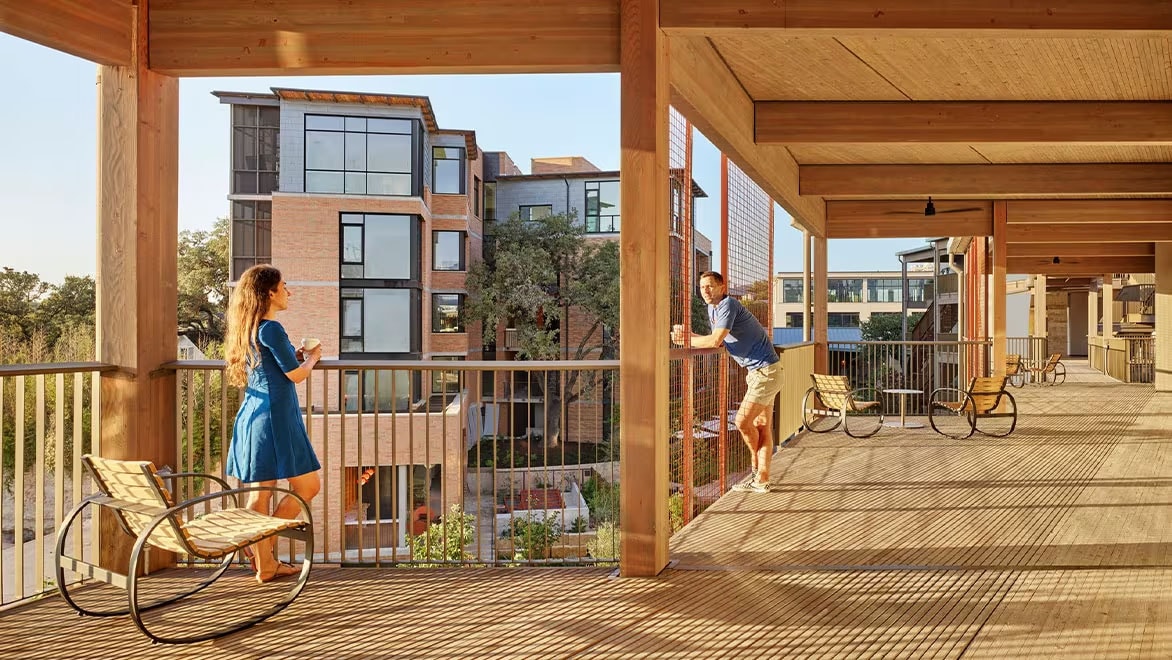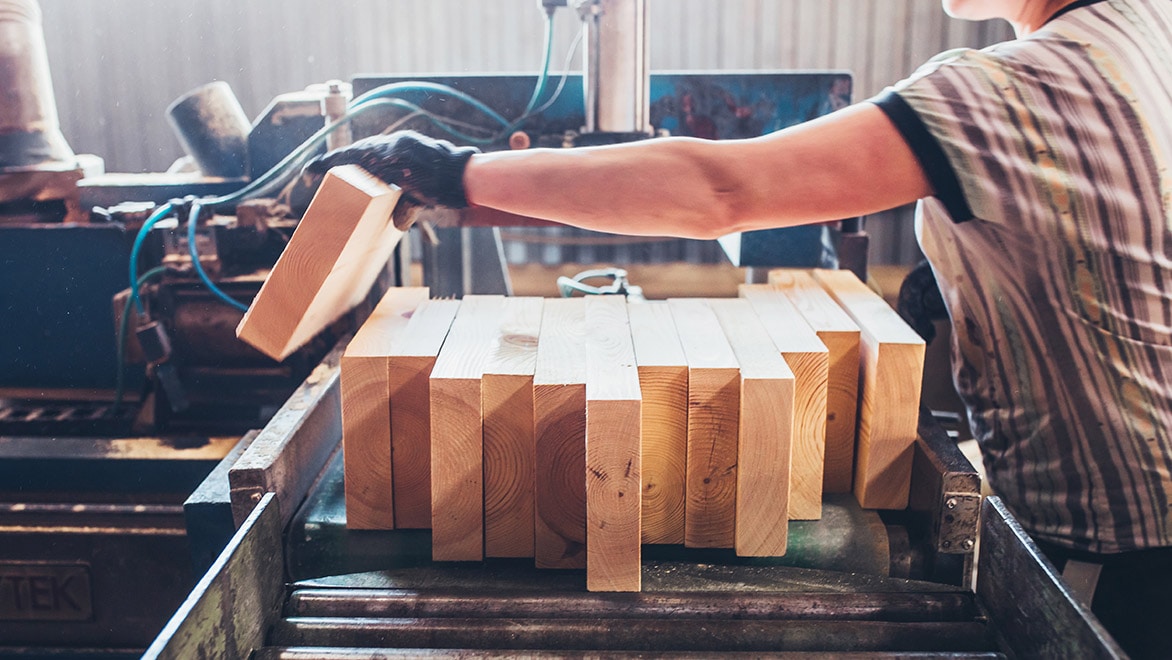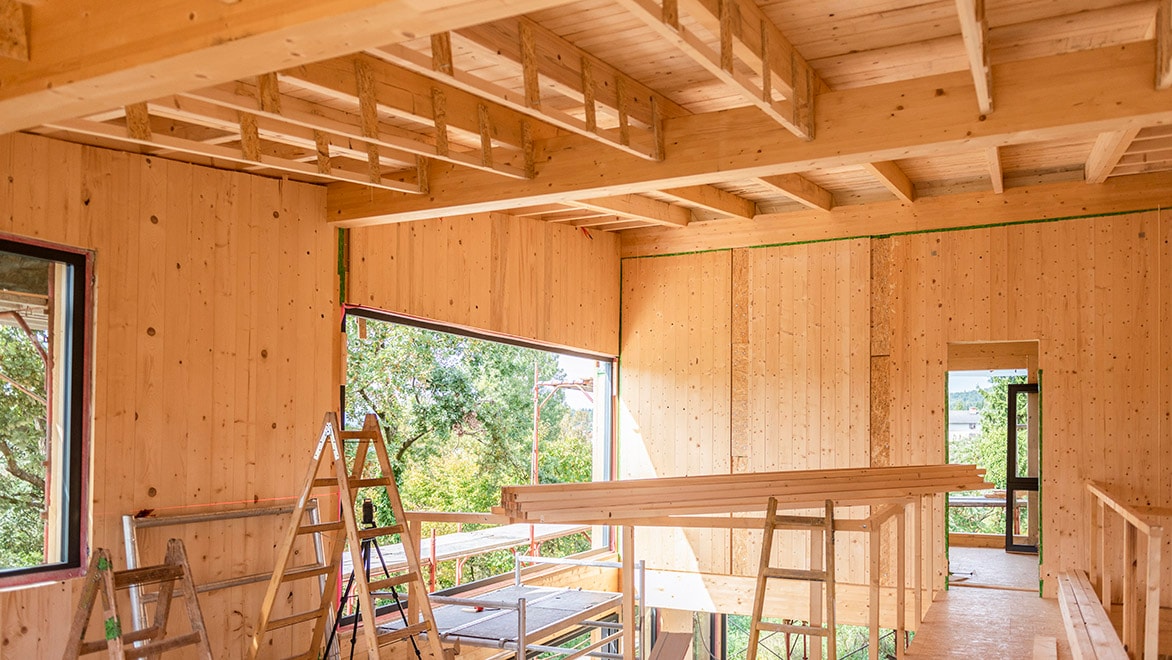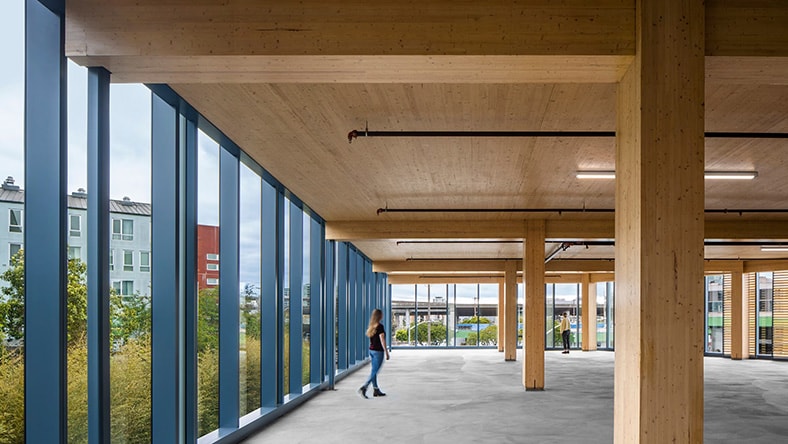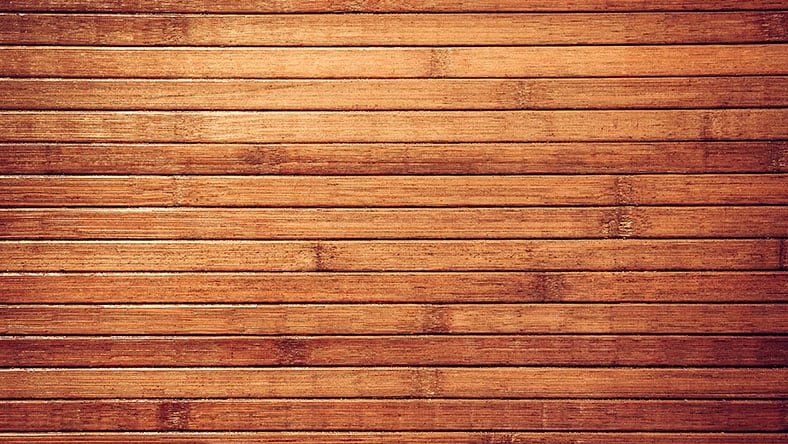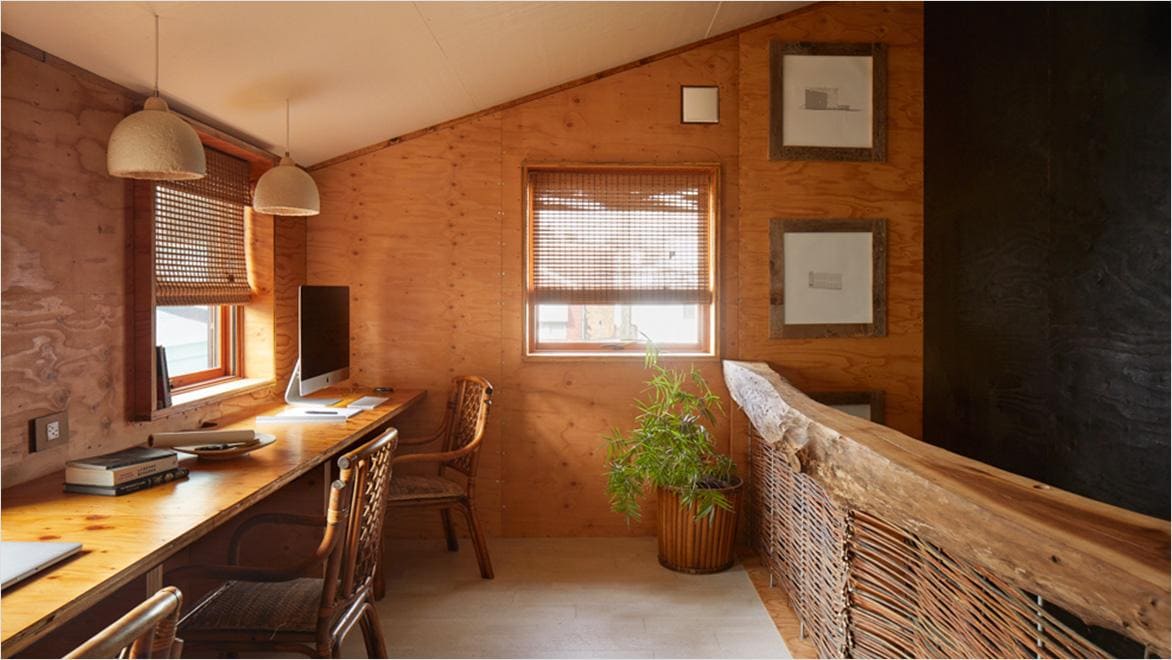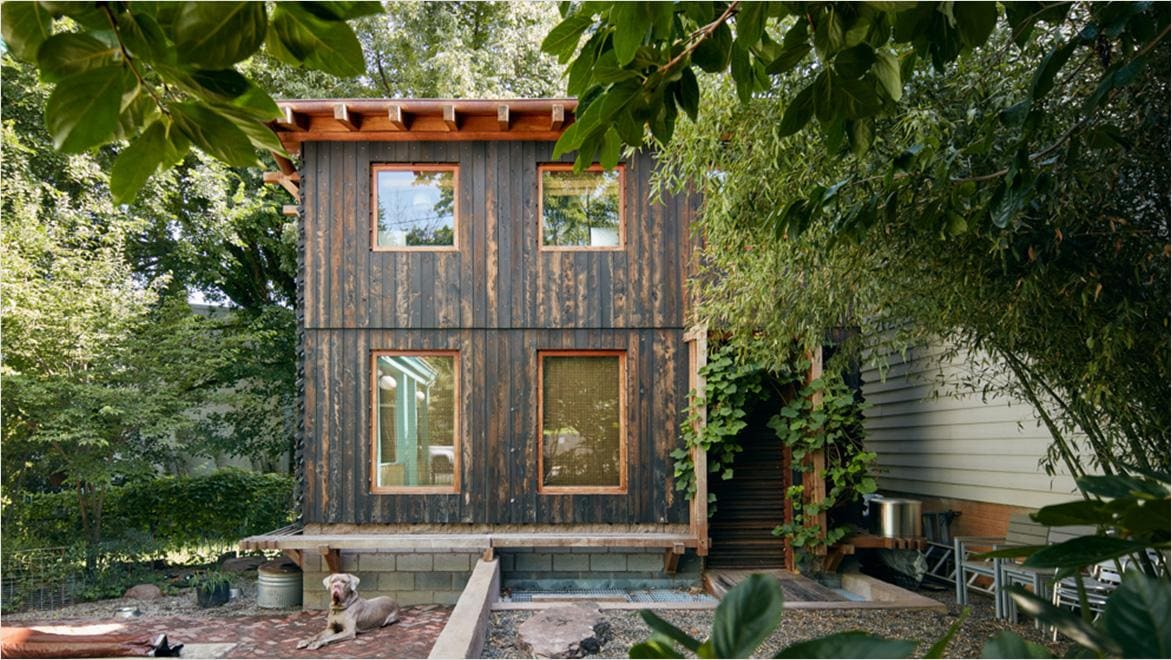& Construction

Integrated BIM tools, including Revit, AutoCAD, and Civil 3D
& Manufacturing

Professional CAD/CAM tools built on Inventor and AutoCAD
Image courtesy of Casey Dunn
Mass timber is a composite building material made from smaller pieces of wood that are glued, nailed or connected together via dowels, dramatically increasing wood’s strength. One powerful benefit of mass timber construction is that its strength is competitive with traditional building materials such as concrete or steel, but its ability to sequester carbon makes it a far more sustainable option.
Mass timber was developed in Europe during the 1990s and has been gaining traction in North American since the mid-2000s. The first modern tall wood building in the United States topped out in 2016, preceded by several projects in Canada.
And while high-rise mass timber projects get the lion’s share of attention, this building system is well-suited to nearly any building type, including big-box stores, university facilities, sports venues and bridges. Compared to steel and concrete, mass timber is lightweight and arrives onsite precut and sized to be installed. This creates cleaner, safer construction sites that function more like those using prefabricated building materials, versus concrete that needs to be poured or steel that’s yet to be welded. Structurally, mass timber works with a variety of framing systems, from simple post-and-beam construction to panelised systems, and various hybrid steel reinforcements.
Timber construction design’s rise is fuelled by its status as a renewable resource – an exceedingly rare characteristic for any building component. What’s more, trees sequester carbon dioxide as they grow, an exemplary benefit of mass timber. Furthermore, mass timber expends relatively little carbon emissions to harvest and shape into useable components. Mass timber is the subject of extensive academic research, pushing the material into new horizons of building performance and novel forms. And, the regulatory and building codes climate is catching up. The 2021 International Building Code approves CLT for buildings up to 18 stories tall, a relatively unprecedented evolution incorporating a completely new building material system into the code structure in one fell swoop.
The thickness of CLT makes it hard to ignite, and if it does, an outer layer of noncombustible char will shield the assembly from the fire and slow critical structural degradation. CLT can maintain fire resistance beyond three hours, in temperatures up to 1,800 degrees Fahrenheit.
Because mass timber is lightweight, it’s able to stand with smaller foundations, which reduce seismic forces during an earthquake.
Mass timber can perform a variety of structural functions, working as beams, columns, panels and sheer walls. Furthermore, it’s one of very few materials that can work nearly anywhere on the building, as internal structure, outer shell or interior finishing.
Not all materials that can hold up a building are also attractive to look at, but timber construction is both. A beam of mass timber can be pleasing to touch, look at and smell, becoming a signature design moment all its own.
Mass timber is one-fifth the weight of concrete and more than 10 times lighter than steel and is competitive with these materials’ strength, depending on the structural application.
For every tonne of steel that rolls off an assembly line, 0.6 tonnes of carbon dioxide are produced. And every tonne of cement manufactured comes with a half-ton of carbon emissions. Growing just one cubic metre of mass timber sequesters and absorbs one metric tonne of carbon dioxide.
Powerful BIM and CAD tools for designers, engineers and contractors, including Revit, AutoCAD, Civil 3D, Autodesk Forma and more.
Plan, design, construct and manage buildings with powerful tools for Building Information Modelling.
2D and 3D CAD tools, with enhanced insights, AI-automations and collaboration features. Subscription includes AutoCAD on desktop, web, mobile and seven specialised toolsets.
Perkins+Will
San Francisco’s 1 De Haro exemplifies commitment to sustainability and illustrates the opportunities possible with whole-life carbon management.
Image courtesy of David Wakely
Lake|Flato Architects
Lake|Flato’s Hotel Magdalena project, the first mass-timber boutique hotel constructed in North America, showcases a design focused on embodied carbon.
Image courtesy of Casey Dunn
BamCore
The Grass House showcases a range of customised facades and finishes, from paint and plaster to masonry, stucco and charred wood.
At Autodesk University 2023, Ariana Cohn, Digital Construction Engineer at Timberlab talked about how mass timber is changing construction today: common myths, reasons to be bullish about the methodology and the steps you can take.
Explore the transformative potential of mass timber construction in combating climate change and role of embodied carbon emissions in building sustainability. Learn from industry experts how innovative techniques and technologies driving sustainability in building design and construction.
See how engineered wood products can help reduce embodied carbon in construction – solving the puzzle of how to meet increasing demand while addressing the climate crisis.
This case study of mid-rise housing using mass timber systems illustrates the reduced carbon footprint and related cost and schedule savings of the design compared to a traditional concrete structure.
This primer on mass timber shows the different types, what they’re used for and the benefits.
Stadium-building has a huge environmental impact in addition to the massive price tag. Modular wood construction could offer greener, more flexible spaces.
Bamboo has the compressive strength of concrete and the tensile strength of steel, but it sequesters carbon as it grows instead of emitting it while it’s made. It replenishes rapidly, and is hollow and lightweight.
Mass timber is a general term applied to many types of engineered wood assemblies; cross-laminated CLT is a specific type of mass timber. Made by stacking dimensional lumber in perpendicular patterns that are glued together, CLT is extremely flexible and can be used as a load-bearing element for structural members, finishing panels, floors, roofs, columns and beams.
Mass timber components are precisely engineered to create composite assemblies of multiple pieces of wood that meet specific structural load and performance goals. Heavy timber construction refers to logs milled from large trees that are used, relatively unaltered, to frame buildings.
As a relatively new building technology, there isn’t much data on the full potential lifespan of mass timber buildings – though there are traditional wood buildings standing today that are almost 1,000 years old, far outlasting the average commercial or residential building in the US, which typically lasts 50–100 years. Wood can be vulnerable to moisture and to pests, but its overall durability is superior to materials like steel and concrete in many situations.
In the United States, building code regulations allow buildings using CLT to reach up to 18 storeys. By placing glulam columns and CLT floors on top of a concrete base, Ascent MKE in Milwaukee is currently the tallest mass timber tower in the world, at 25 storeys and 284 feet high.
Mass timber can have more tensile strength than concrete and more compressive strength than steel, though the exact strength qualities of mass timber and its many applications are still being explored.
